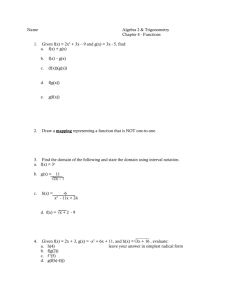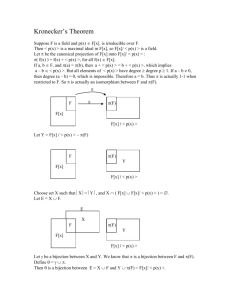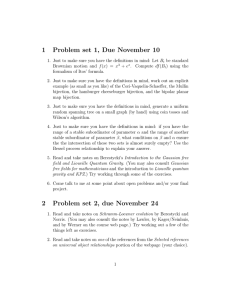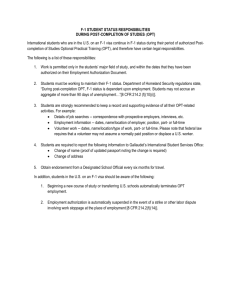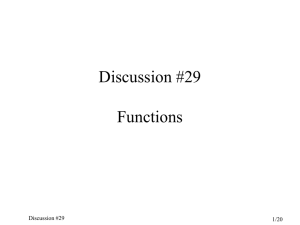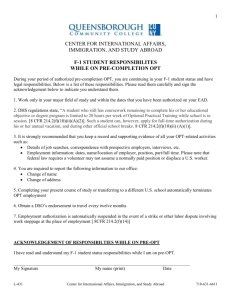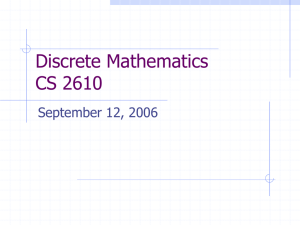Homework Solutions
advertisement
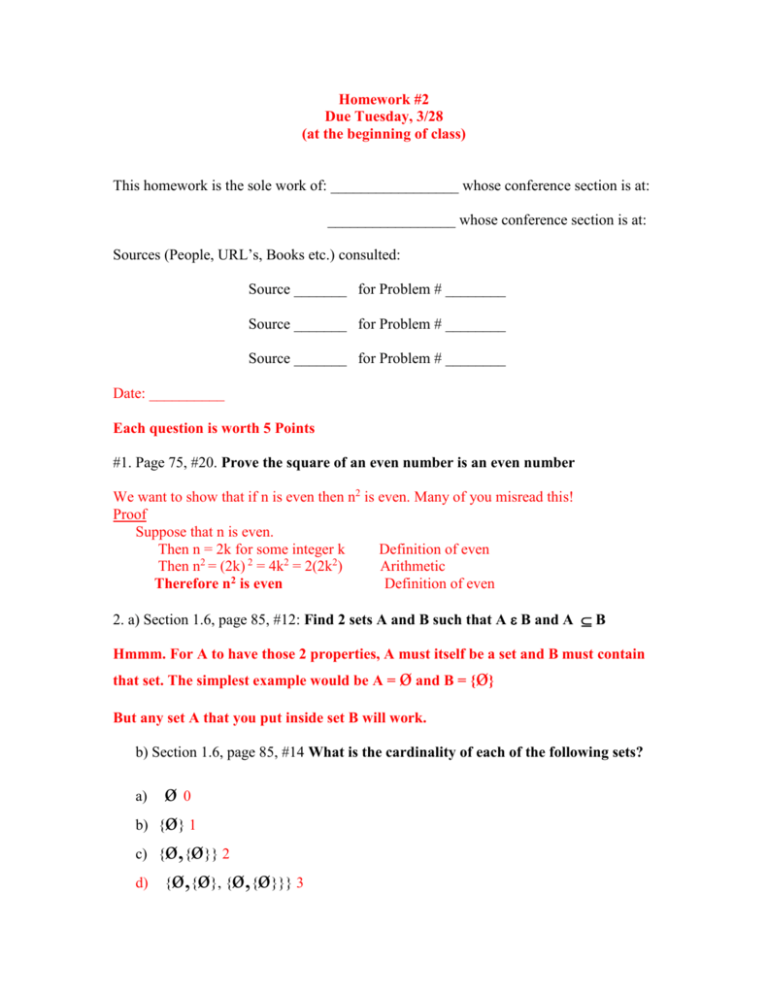
Homework #2
Due Tuesday, 3/28
(at the beginning of class)
This homework is the sole work of: _________________ whose conference section is at:
_________________ whose conference section is at:
Sources (People, URL’s, Books etc.) consulted:
Source _______ for Problem # ________
Source _______ for Problem # ________
Source _______ for Problem # ________
Date: __________
Each question is worth 5 Points
#1. Page 75, #20. Prove the square of an even number is an even number
We want to show that if n is even then n2 is even. Many of you misread this!
Proof
Suppose that n is even.
Then n = 2k for some integer k
Definition of even
Then n2 = (2k) 2 = 4k2 = 2(2k2)
Arithmetic
2
Therefore n is even
Definition of even
2. a) Section 1.6, page 85, #12: Find 2 sets A and B such that A B and A B
Hmmm. For A to have those 2 properties, A must itself be a set and B must contain
that set. The simplest example would be A =
ø and B = {ø}
But any set A that you put inside set B will work.
b) Section 1.6, page 85, #14 What is the cardinality of each of the following sets?
a)
b)
c)
d)
ø0
{ø} 1
{ø,{ø}} 2
{ø,{ø}, {ø,{ø}}} 3
#3. a) Section 1.6, page 85, #16: Can you conclude that A = B if A and B are 2 sets
with the same power set? Why or why not?
The union of all the sets in the power set of X is X, so we can recover a set from its
power set. The answer is “yes”
b) Section 1.6, page 86, #22: Suppose that A x B =
What can you conclude?
ø, where A and B are sets.
One of A or B (or both) must be empty (if neither A nor B were empty, there would be an
element in AxB)
#4. a) Section 1.7, page 95, #14a,e: Let A, B and C be sets. Show that
a) ( A U B) ( A U B U C)
(i)
in words by showing the appropriate subset relations as done in class
Suppose x A U B
Then x A or B
Therefore x A U B U C
(truthfully, this is almost given to be true by the definition of union)
b) (B – A) U (C – A) = (B U C) – A
We need to show:
1. (B – A) U (C – A) (B U C) – A
and 2. (B U C) – A (B – A) U (C – A)
1. (B – A) U (C – A) (B U C) – A
If x (B – A) U (C – A), then x B – A or x C – A
Case 1 x B – A
Then x B so x B U C
And x is not in A
So x ((B U C) – A
Case 2 x C – A
Then x C so x B U C
And x is not in A
So, again, x ((B U C) – A
2. (B U C) – A (B – A) U (C – A)
x (B U C) – A
Then x B or x C AND x is not in A
Case 1
x B AND x is not in A
Then x B – A
So x (B – A) U (C – A)
Case 2
x C AND x is not in A
Then x C – A
So x (B – A) U (C – A)
(B U C) – A (B – A) U (C – A)
We have shown (B – A) U (C – A) = (B U C) – A
(ii)
using Venn diagrams
#5. a) Determine whether each of these functions is a bijection. If it is a bijection,
prove it; if not a bijection, give a counterexample.
A bijection is a 1-1 and onto function
a) f: R Z: f(x) = |_x_| (that is, f(x) = floor(x))
1-1
Not 1-1. For example floor(1.1) = floor(1) = a
onto
It is onto: Given any integer n, floor(n) = n (among others)
b) f: R R: f(x) = x2
1-1
Not 1-1. For example -1 1 and 1 1
onto
It is onto. For any x in the codomain, sqrt(x) x
c) f: {1,2,3} {2}: {(1,2). (2,2), (3,2)}
1-1
Not 1-1: All numbers map to 2
Onto
It is onto since {2} is the entire codomain and at least (actually 3) number in the domain
maps to 2.
d) f: {1,2,3} {1,2, 3}: {(1,2), (1,3), (2,1), (2,2)}
Not even a function! 1 maps to both 2 and 3 (and 2 maps to both 1 and 2).
b) Let f be a function from the set A to the set B. Let S and T be subsets of A, R a
subset of B. Show that:
a) f(S U T) = f(S) U f(T)
If y f(SUT), then x SUT such that f(x) = y
Then x S or x T.
Case 1
xS
Then f(x) f(S)
So f(x) f(S) U f(T)
Case 2
xT
Then f(x) f(T)
So f(x) f(S) U f(T)
b) f(f-1(R))
R
Suppose y f(f-1(R)). Then x f-1(R)) such that f(x) = y
If x f-1(R)) then f(x) R (by definition)
Thus, f(f-1(R))
R
#6. Show that 5n is O(6n), but 6n is not O(5n)
Since 5n < 6n for all n > 0, 5n is O(6n) (C = 1, k = 0).
If 6n were O(5n), then for some C, 6n < C5n, for sufficiently large n.
That is C > (6/5)n for all sufficiently large n, which is impossible.
#7. Section 2.2, page 142, #16 Show that if f(x) is O(x2), then f(x) is O(x3)
if f(x) is O(x2), then |f(x)| < C x2 for all x > k, some C.
Let k’ = max (k,1).
|x2| < |x3| for all x > 1, so |f(x)| < C |x3| for all x > k’.
#8. Express each statement using -, O- or - notation
a) Show that 2x + 17 is O(3x).
If x > 5, 2x + 17 < 2x + 2x = 2 * 2x < 2 * 3x so 2x + 17 is O(3x) (C = 2, k = 5)
b) Show that (x3 + 2x)/(2x+1) is O(x2)
(x3 + 2x)/(2x+1) < (x3 + 2x3)/(2x) = 3/2 x2
So, (x3 + 2x)/(2x+1) is O(x2) with k = 1, C = 3/2
c) Show that 2x2 +x -7 is (x2)
For large x, x2 < 2x2 +x -7
For x > 1, 2x2 +x -7 < 3x2
d) Show that floor(x + ½) is (x)
For x > 2, floor (x + ½) < 2x and also x < 2 floor(x + ½)
e) Show that ceiling(xy) is (xy)
For all positive values of x and y, ceiling(xy) > xy.
Thus, ceiling(xy) = (xy) (with C = 1 and k1 = k2 = 0)
